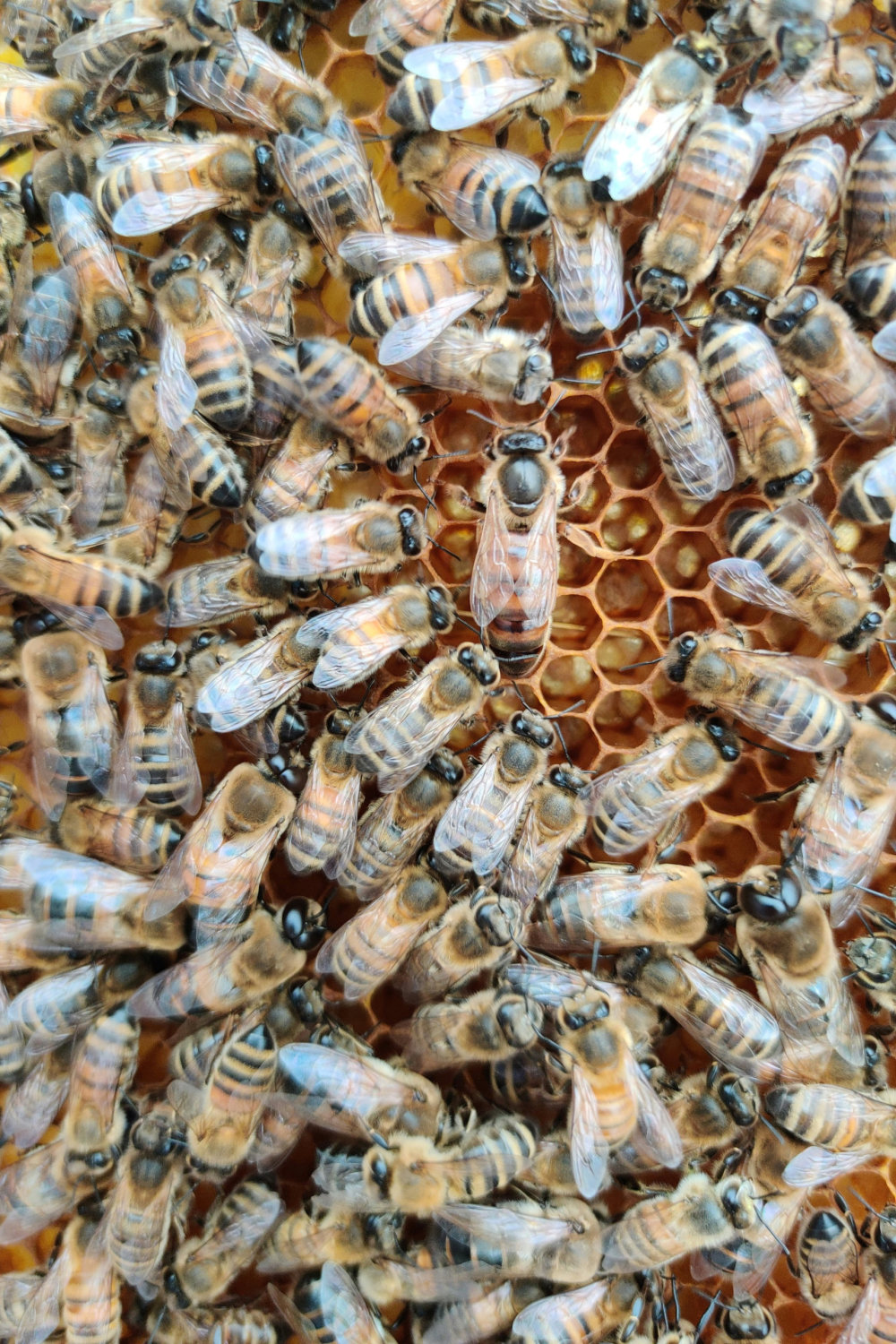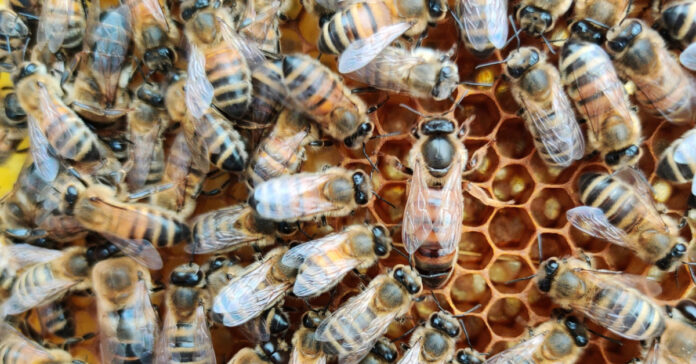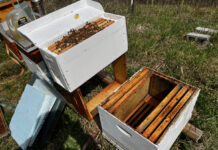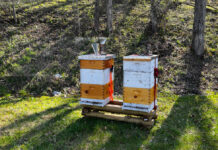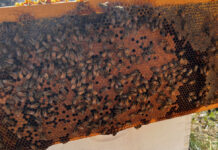Back on Easter Weekend, I took advantage of a few days of warm weather to inspect all five beehives. What I saw was several hives that were bigger than I had ever seen them at this time of year.
Ideally, you want the number of honeybees in your hive to peak around the time the honey flow starts, which means your local plants are producing so much nectar your bees can make a great crop of honey. My bees were in danger of peaking early. When that happens, the hive swarms, meaning somewhere between 30 to 70 percent of the bees, led by the queen, fly off to find another hive, leaving behind a new queen and a bunch of bees to help her rebuild the hive.
Beekeepers don’t like swarms because when bees fly off and are never heard from again, we lose a valuable resource. Not only is that $200 worth of bees, it’s a great deal of future honey-making potential. A swarm could be conservatively estimated to cost a beekeeper $500.
I take pride in preventing swarms, which I think is a goal all serious beekeepers should have. The best way to do that is to split the hive, moving the queen and a bunch of bees to a new hive. This convinces the queen and her worker bees that they have already swarmed, which usually stops the instinctual need to swarm. It also allows the beekeeper to maintain control of his hives. I call that a win-win.
This works best when you find queen cells in your hives or have a queen you can drop into your splits. Mine had not yet reached that stage, so I took an alternative approach.
Creating Nucs and Making Queens
After inspecting my five hives, I decided four of them were large enough that I needed to reduce the swarm pressure. I decided to take some resources from these hives to allow them room to expand.
I set up two large 10-frame hive bodies and pulled a couple frames of brood and a frame or two of pollen and nectar from the strong hives and added them to each nucleus hive, or nuc. Then, I took the empty frames that had been in the new hive and checker boarded them into the existing hives, replacing the frames I pulled. About half of these were drawn comb, half just had foundation. This will give the big hives more breathing room.
For the bees to create their own queen, they need to start with very young eggs. I made sure each nuc had two frames that had eggs and very young larvae. I also made sure they had at least a frame of mature, capped brood. This would give the new hives bees that would hatch soon. To boost these new hives, I also shook some nurse bees from other hives into the nucs. Because nurse bees are too young to fly, they are forced to stick in their new hives. Foragers, on the other hand, will fly out of their new hive and return to the old one.
Be sure to carefully check each frame you move or shake to avoid moving the queen into the new hive.
I started the afternoon with four hives. Three hours later, I had six, although two of them were small-ish and queenless. I crossed my fingers that the new hives would not only survive the cold snap but produce their own queen.
Cold, Wet Weather
Early April may be spring, but we still have days when it can feel like winter and nights when the temperatures drop into the 20s. We had quite a few cold days, lots of rain, some sleet, and a little snow. Then more rain. Lots more. I was glad we lived on a hill instead of a flood plain.
When the rained ended, I checked the front of the two nucs and one had a good number of bees flying in and out. The other only had a few. I was worried, but it was too soon to do anything. If the hives successfully made queens, the queen cells would be very tender and weak, making it the wrong time to open the hives and move frames.
When the time was finally right, we had decent weather, and I had a day off, I opened the hives and was happy to see that both were in decent shape. The bees were happy and docile, which generally means they are “queen right.” Hives that have no queen or queen cells waiting to hatch tend to be angry and aggressive. I took the calmness it as a good sign.
Between the two hives, I found four queen cells, all capped and looking good. In the next day or two, the queens should emerge from their cell. The first one born will try to kill any unborn queens. If they are born at the same time, they will fight it out until one claims the “throne,” or at least the hive.
Mating Flights
When a queen is born, or emerges, she is considered a “virgin queen” because she is unmated. After a few days in the hive, a virgin will go on her mating flight. Technically, this can be several flights over several days, but we beekeepers have a habit of saying a mating flight. During this period, she will mate with dozens of drones, which are male bees. (Worker bees are all females.) Thirty drones are considered a good minimum number of mates as the more varied the genetic makeup of the sperm she receives, the better for her offspring and the stronger the hive. For similar reason, queens will not mate with drones from their own hive and prefer to find drones that are not even from their own apiary.
After a drone mates with a queen, his reason for living is over and it dies. While the queen lives, the mating flight is dangerous and around 20 percent of queens don’t make it back to the hive. Some get eaten and others get lost. In crowded apiaries, they may even come back and enter the wrong hive.
I like to check my hives 10 to 14 days after a virgin emerges to see if there are any eggs or larvae in the hive. If so, I know the queen returned and is hard at work. If not, the process has to start over again. Or, I can buy a queen for about $35 and drop her in. If one hive has a queen and the other doesn’t, the easiest thing might be to combine the two hives into one double-deep hive.
After the queen returns and starts laying, she will never leave the hive again unless the hive swarms.
Bee Reproduction
When a queen lays eggs, laypeople think of this as reproduction, just like a hen might lay eggs and raise a batch of chicks. I consider it replenishment. The normal lifespan of a honeybee is six weeks, so unlike chickens, the bees need to replenish their numbers constantly.
To actually reproduce, the hive must split or swarm, thereby creating two colonies. I consider the colony to be the organism, not the individual bee. This perspective helps when you close the hive and crush a bee by mistake or have to kill 300 in a mite test. The individual bees are part of the larger colony of bees, but the health of the colony is what matters.
I am at the stage of beekeeping when I don’t need to buy any more bees. I have enough hives that they will either reproduce on their own (swarm) or give me enough resources to split one robust hive into two or more new hives. In fact, any skilled beekeeper with three or more hives should be able to do the same thing.
If I worked at it, I could split my original five hives into 20 or 30 by July. I wouldn’t make much honey because I would be focused on making bees instead of honey. Selling 20 nucs would potentially make $3600 in profit while selling 20 full colonies would generate even more revenue. I would do this if I was in a pinch, but it’s less work and more fun to sit back, let the bees do the work, and harvest honey. With any luck, I’ll set a record for honey production this year.
